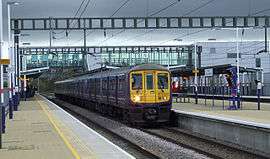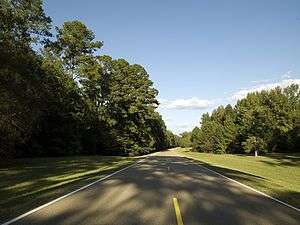Parkway


A parkway is a broad, landscaped highway thoroughfare.[1] The term is particularly used for a roadway in a park or connecting to a park from which trucks and other heavy vehicles are excluded.[1] Many parkways originally intended for scenic, recreational driving have evolved into major urban and commuter routes.
The term parkway is sometimes applied more generally to a variety of limited-access roads.
United States
Scenic roads
Over the years, many different types of roads have been labeled parkways.
The first parkways in the United States were developed during the late 19th century by landscape architects Frederick Law Olmsted and Beatrix Farrand as roads segregated for pedestrians, bicyclists, equestrians, and horse carriages, such as the Eastern Parkway, which is credited as the world's first parkway,[2] and Ocean Parkway in the New York City borough of Brooklyn. The terminology "parkway" to define this type of road was coined by Calvert Vaux and Frederick Law Olmsted in their proposal to link city and suburban parks with "pleasure roads."
Newer roads such as Bidwell in Buffalo, New York and Park Presidio Boulevard in San Francisco, California[3] were designed for automobiles and are broad and divided by large landscaped central medians.
During the early 20th century, the meaning of the word was expanded to include limited-access highways designed for recreational driving of automobiles, with landscaping. These parkways originally provided scenic routes without very slow or commercial vehicles, at grade intersections, or pedestrian traffic such as the Merritt Parkway in Connecticut and the Vanderbilt Motor Parkway in New York. Their success led to more development however, expanding a city's boundaries, eventually limiting their recreational driving use. The Arroyo Seco Parkway between Downtown Los Angeles and Pasadena, California is an example of lost pastoral aesthetics. It and others have become major commuting routes, while retaining the name parkway.
Early high speed roads
In New York City, construction on the Long Island Motor Parkway (Vanderbilt Parkway) began in 1906 and planning for the Bronx River Parkway in 1907. In the 1920s, the New York City Metropolitan Area's parkway system grew under the direction of Robert Moses, the president of the New York State Council of Parks and Long Island State Park Commission, who used parkways to create and access state parks, especially for city dwellers. As Commissioner of New York City Parks under Mayor LaGuardia, he extended the parkways to the heart of the city, creating and linking its parks to the greater metropolitan systems.
Most of the New York metropolitan parkways were designed by Gilmore Clark. The famed "Gateway to New England" Merritt Parkway in Connecticut was designed in the 1930s as a pleasurable alternative for affluent locals to the congested Boston Post Road, running through forest with each bridge designed uniquely to enhance the scenery. Another example is the Sprain Brook Parkway from The Bronx to become the Taconic State Parkway to Chatham, New York. Landscape architect George Kessler designed extensive parkway systems for Kansas City, Missouri; Memphis, Tennessee; Indianapolis; and other cities at the beginning of the 20th century.
New Deal roads
In the 1930s, as part of the New Deal the U.S. federal government constructed National Parkways designed for recreational driving and to commemorate historic trails and routes. These divided four-lane parkways have lower speed limits and are maintained by the National Park Service. An example is the Civilian Conservation Corps (CCC) built Blue Ridge Parkway in the Appalachian Mountains of North Carolina and Virginia.
Others are: Skyline Drive in Virginia; the Natchez Trace Parkway in Mississippi, Alabama, and Tennessee; and the Colonial Parkway in eastern Virginia's Historic Triangle area. . The George Washington Memorial Parkway and the Clara Barton Parkway, running along the Potomac River near Washington, D.C., were also constructed during this era.
Post-war parkways
In Kentucky the term "parkway" designates a controlled-access highway in the Kentucky Parkway system, with nine built in the 1960s and 1970s. They were toll roads until the construction bonds were repaid, now being freeways since 2006.
The Arroyo Seco Parkway from Pasadena to Los Angeles, built in 1940, was the first segment of the vast Southern California freeway system. It became part of State Route 110 and was renamed the Pasadena Freeway. A 2010 restoration of the freeway brought the Arroyo Seco Parkway designation back.

In the New York metropolitan area, contemporary parkways are predominantly controlled-access highways restricted to non-commercial traffic, excluding trucks and tractor-trailers. Some have low overpasses that also exclude buses. The Vanderbilt Parkway, an exception in western Suffolk County, is a surviving remnant of the Long Island Motor Parkway that became a surface street, no longer with controlled-access or non-commercial vehicle restrictions. The Palisades Interstate Parkway is a post-war parkway that starts at the George Washington Bridge, heads north through New Jersey, continuing through Rockland and Orange counties in New York. The Palisades Parkway was built to allow for a direct route from New York City to Harriman State Park.
In New Jersey, the Garden State Parkway, connecting the urban Northeast U.S. with the rural Atlantic Ocean shoreline and Atlantic City, is restricted to buses and non-commercial traffic north of the Route 18 interchange but is one of the busiest toll roads in the country.[4]
In the Pittsburgh region, two of the major interstates are referred to informally as Parkways. The Parkway East — I-376, formally the Penn-Lincoln Parkway, connects Downtown Pittsburgh to Monroeville, Pennsylvania. The Parkway West — I-376 runs through the Fort Pitt Tunnel and links Downtown to Pittsburgh International Airport, Southbound I-79, Imperial, Pennsylvania, and Westbound US 22/30. The Parkway North — I-279 connects Downtown to Franklin Park, Pennsylvania and Northbound I-79.
In Minneapolis, the Grand Rounds Scenic Byway system has 50 miles (80 km) of streets designated as parkways. These are not freeways, having a slow 25-mile per hour speed limit, pedestrian crossings, and stop signs.[5][6]
In Cincinnati, parkways are major roads which trucks are prohibited from using. Some Cincinnati parkways, such as Columbia Parkway, are high-speed, limited access roads, while others, such as Central Parkway, are multi-lane urban roads without controlled access. Columbia Parkway carries US-50 traffic from downtown towards east-side suburbs of Mariemont, Anderson, and Milford, and is a limited access road from downtown to the Village of Mariemont.
Canada

"Parkway" is used in the names of many Canadian roads, including major routes through national parks, scenic drives, major urban thoroughfares, and even regular freeways that carry commercial traffic.
Parkways in the National Capital Region are administered by the National Capital Region (Canada). However, some of them are named "Drive" or "Driveway".
The term in Canada is also applied to multi-use paths and greenways used by walkers and cyclists.[7][8]
United Kingdom
The United Kingdom have parkways in most large towns and cities. Some parkways are either motorways or 'A/B roads.' Some parkways, like in Chelmsford have flyovers leading to major roads.
Peterborough
The city and third generation new town of Peterborough with a population of 184,500 (2011 est.) has a well-built and developed system of designated Parkways which help to provide easy access to the city centre itself and its surrounding townships, the majority of which are dual-carriageway with many of their junctions numbered.
Bristol (and other) park-and-ride railway stations

English park-and-ride railway stations have the suffix Parkway, although the etymology is from the original U.S. meaning, with the Bristol Parkway railway station named after the adjacent M32 motorway originally known as the Parkway because of its rural route into the city.
Luton Airport Parkway is a railway station serving Luton Airport. It was given the name as the station is not directly next to the airport resulting in the need for shuttle bus services to operate from the station to the terminal.
Plymouth
In the City of Plymouth, the A38 is called 'The Parkway' and goes through the more rural parts of the Authority area, which coincide with its geographical (but not commercial) centre. It is limited access, and only has one or two junctions to enter the city.
Australia
Australian Capital Territory
The Australian Capital Territory uses the term "Parkway" to refer to roadways of a standard approximately equivalent to what would be designated as an "Expressway", "Freeway", or "Motorway" in other areas. Parkways generally have multiple lanes in each direction of travel, no intersections (crossroads are accessed by interchanges), high speed limits, and are of dual carriageway design (or have high crash barriers on the median).[9]
See also
| Look up parkway in Wiktionary, the free dictionary. |
References
- 1 2 "parkway."Webster's Third New International Dictionary, Unabridged. Merriam-Webster, 2002. http://unabridged.merriam-webster.com (14 Apr. 2007).
- ↑ http://www.nycgovparks.org/about/history/historical-signs/listings?id=196
- ↑ Alexander, Jeanne. "History of Park Presidio Boulevard". ppnsf.org/history.
- ↑ "TITLE 16. DEPARTMENT OF TRANSPORTATION - CHAPTER 32. TRUCK ACCESS" (PDF). New Jersey Department of Transportation. Retrieved August 13, 2010.
- ↑ "Information Center: About the Grand Rounds". Retrieved 2007-12-18.
- ↑ "Second Ward, Minneapolis: Traffic Calming Event". Retrieved 2007-12-18.
- ↑ BC Parkway, Vancouver, British Columbia, Canada
- ↑ Welland Canals Parkway Trail, Canada
- ↑ EPBC Referral - Majura Parkway to DEWHA (Revision 1), SMEC, Page 9, 19 August 2009
External links
| Look up parkway in Wiktionary, the free dictionary. |
- NPS: Blue Ridge Parkway website
- NPS: Natchez Trace Parkway website
- Natchez Trace Compact
- Long Island Motor Parkway
- Bronx River Parkway
- Merritt Parkway
- The Straight Dope "Why do we drive on the parkway and park on the driveway?"
- NPS Colonial Parkway webpage

